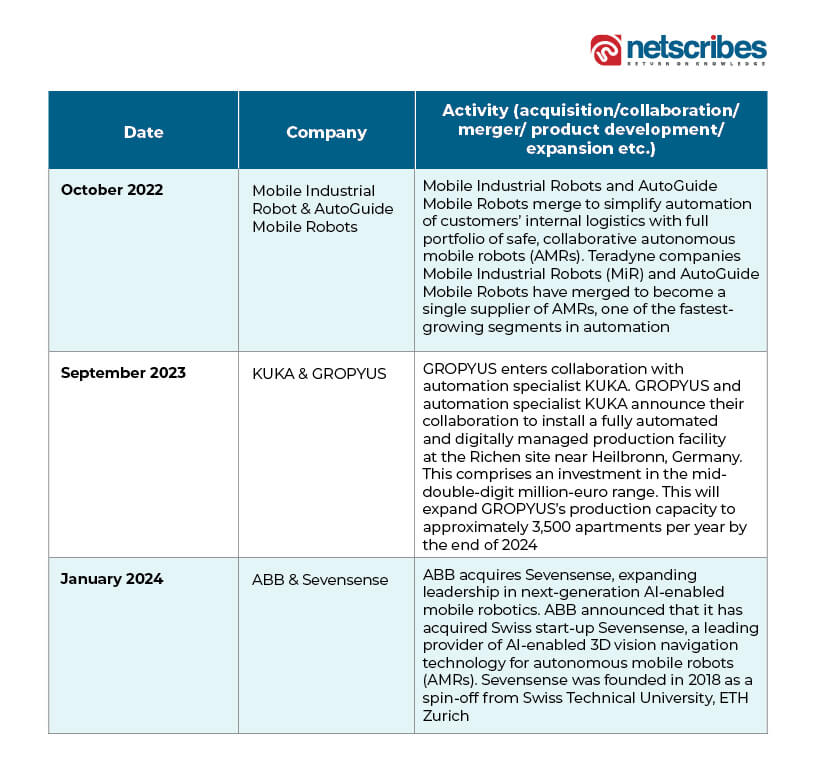Highlights
- The global industrial robots market is set to exceed a 10% growth rate, targeting a valuation surpassing USD 35 billion by 2029, as robotics integration reshapes modern manufacturing.
- Robotics integration, combining cutting-edge technologies like system integrators, feeding systems, and vision systems, is driving automated solutions for tasks ranging from assembly and painting to production inspection.
- Tech giants such as Siemens, UiPath, Oracle, and Microsoft are at the forefront of robotics integration, creating digital workforces that seamlessly blend robots, systems, and human collaboration.
- The global market for robotic system integrators is expected to surge at a CAGR of over 15% in the next five years, attracting investments and revolutionizing industries like automotive, electronics, and logistics. The fusion of robotics with smart cities is also reshaping the future of human living.
In the unfolding narrative of technology, we’re about to witness a captivating chapter in the world of robotics and its integration. The global industrial robots market is gearing up for a riveting surge, projecting a growth rate that cruises past 10%, eyeing a valuation north of USD 35 billion by 2029. This isn’t your typical tech talk; it’s a front-row ticket to the dazzling spectacle of industrial robots reshaping the very fabric of modern manufacturing.
Robotics integration is not merely a process but a synergy of cutting-edge technologies—system integrators, feeding systems, and vision systems—that converge to create automated solutions. From precision tasks like assembling, painting, palletizing, and production inspection to comprehensive testing across diverse industries, the integration process involves the artful programming of these systems.

Navigating trends and challenges
The demand for industrial robots tailored for specific applications – be it arc welding, materials handling, or painting, propels the robotics system integration market forward. However, with innovation comes disruption. The surge in specialized robotic applications has led to unemployment concerns, particularly in nations like China and India. Yet, the narrative pivots as a human-centric approach emerges, fostering skill-centric employment across manufacturing industries.

Integration of robotic technology into manufacturing processes isn’t just a technological feat; it’s a strategic move laden with benefits. From heightened accuracy and consistency in repetitive tasks to increased speed and cost-effectiveness, the impact is far-reaching. Employers witness a confluence of perks, from reduced labor costs to the optimal utilization of skills, as industrial robots handle routine tasks, thus fostering a safer workplace.
Tech giants and integration pioneers
Tech titans like Siemens SIMATIC Robot Integrator, UiPath Robotic Process Automation (RPA), Oracle Integration Cloud Service, and Microsoft Power Automate take center stage. These platforms propel the integration capabilities, creating a digital workforce seamlessly blending robots, systems, and people.
The untapped potential and market dynamics
Robotic process integration is heralded as a catalyst for economic growth and heightened business productivity, attracting investments for further exploration. The global market for robotic system integrators is poised for robust growth, expected to surge at a CAGR of over 15% in the next five years. We see a slew of companies securing investments to delve into fresh opportunities and pioneer advancements in the realm of Robotic Process Automation (RPA). Here are a few noteworthy examples:

Application across industries
Robotic system integration finds its place across diverse sectors—from automotive and electronics to logistics. The automotive sector stands out as a fervent adopter, though the logistics sector currently outpaces others in adoption rates. In process industries, the pursuit of heightened productivity and punctual project delivery seamlessly aligns with the overarching vision of fully automating manufacturing processes.
Prominent players in the worldwide robotics system integration market include:

Shifting gears, the fusion of robotics with the burgeoning concept of smart cities is reshaping the future of human living. From connected devices to service robots these fields have become indispensable in our everyday lives. The Smart Cities Robotics Challenge (SciRoc) emerges as a beacon, fostering advances in the integration between robots and smart cities.
Global robotics system integration market: Key developments

Global impact and the road ahead
To sum it all robotics integration is experiencing a paradigm shift, with the potential to bring manufacturing production work back to developed countries. Yet, it doesn’t shy away from acknowledging potential challenges. It foresees a 3%-5% shift in occupational categories and the need for new skills by 2030. With each advancement, we are not just shaping the future of the industry. We are paving the way for a more connected, efficient, and automated world. The key lies in our collective ability to adapt, innovate, and embrace the possibilities that the robotics integration unfolds before us.
Netscribes technology research and insights solution offers a comprehensive view of varied robot system integration markets, technologies, and the investment landscape. We have a multi-disciplinary team of Ph.D. holders, engineers, statisticians, economists, and business management consultants. They provide detailed insights and market analysis on the robot system integration industry, contact us.
Based on insights by Husen Limdiwala, Manager, Market Research






